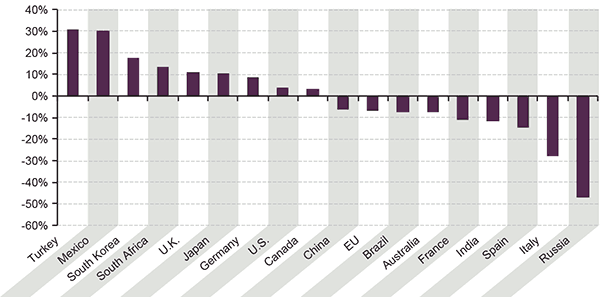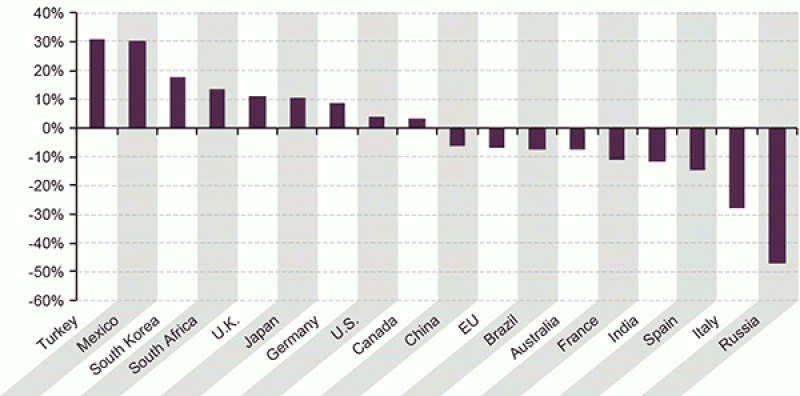September 25 2013
While U.S. stocks are increasingly due for a consolidation, the outlook for global equities is improving. Now appears to be a good time for investors to increase allocations toward Asia and Europe.
Global CIO Commentary by Scott Minerd, Guggenheim Partners LLC
U.S. equities have become further extended, and there is a risk that the increasing economic headwinds could negatively affect earnings and share prices as the end of the year approaches. Additionally, the United States faces ongoing uncertainty over monetary policy and increasing concern in Washington about a possible government shutdown. With only three months remaining in 2013, a rebound in economic growth does not appear likely before the first or second quarter of 2014. The outlook for the economies and markets of Asia and Europe, however, appears much more positive, which the current decrease in U.S. interest rates will only reinforce.
Continued U.S. monetary stimulus is good news for Asian and particularly Chinese stocks, the valuations of which have been battered down to levels not seen since 2006. The bearish view holds that China has done little to address its structural problems. However, the same argument could have been made about the United States in 2009, at the outset of a rally that saw equities rise by 151 percent to their current historical highs. Importantly, in the near-term, Chinese economic data (including the recent purchasing managers and industrial production numbers) is showing cyclical improvement.
In Europe, Chancellor Angela Merkel’s re-election in Germany and the announcement by European Central Bank President Mario Draghi that more long-term refinancing could be available for banks bode well for economic recovery. Although headwinds remain, Europe has established a fairly sound base and lower interest rates should mean the continent’s recent economic momentum will pick up. This will almost certainly translate into higher prices for European stocks, which have a great deal of headroom.
It appears that Asia and Europe will be the biggest winners from the U.S. Federal Reserve’s decision to maintain extreme monetary accommodation. Investors should consider using strength in U.S. indices to lighten up domestic positions and gain greater exposure to overseas markets. The all-clear signals coming out of those regions indicate non-U.S. stocks have a great deal of potential upside for at least the next three to six months.
Chart of the Week
European, BRICs Stocks Undervalued
A country’s market capitalization as a percent of GDP is a useful indicator in assessing whether an equity market is under- or overvalued. Making direct comparisons between developed markets and emerging markets can be difficult, however, because the latter tend to have less developed stock markets and lower market capitalization to GDP ratios. A more useful indicator is to compare a country’s ratio to its historic levels. Based on current differences from previous 10 year averages, European markets, especially Italy, Spain, and France, appear particularly undervalued and therefore attractive. Additionally, the BRICs (Brazil, Russia, India, China) countries are currently below their averages, suggesting now may be a good buying opportunity.
MARKET CAPITALIZATION, % OF GDP: DEVIATION FROM PRIOR 10-YEAR AVERAGE

Source: Bloomberg, Haver Analytics, Guggenheim Investments. Data as of Q2 2013.
Economic Data Releases
U.S. Housing Data Mixed
- New home sales increased 7.9% in August to an annualized pace of 421,000. Even with the gain, new home sales were at the second lowest level this year.
- The S&P/Case-Shiller 20-city home price index rose 12.4% in July from a year earlier, the fastest rate since February 2006. The month-over-month rate, however, was the slowest in 10 months at 0.6%.
- The FHFA house price index increased 1.0% in July, a four-month high.
- Mortgage applications rose 5.5% for the week ended September 20th, the first consecutive weekly increase since the first week of May as mortgage rates moved lower.
- Durable goods orders inched up 0.1% in August, after plunging 8.1% in July. Non-defense capital goods, excluding aircraft, rebounded to 1.5% growth. Gains were led by motor vehicles.
- The Conference Board’s consumer confidence index dropped to 79.7 in September from 81.8 in August. The present situation index rose while expectations dropped significantly.
- The Richmond Fed index fell much more-than-expected in September, down from 14 to 0.
- The Chicago Fed National Activity Index rose more than expected to 0.14 in August, the first month with a positive reading since February.
European PMIs and Confidence Make New Highs, Chinese Manufacturing Accelerates
- The euro zone composite PMI beat expectations in the September advance reading, rising to 52.1, the highest level since June 2011.
- The euro zone manufacturing PMI fell slightly, down from 51.4 to 51.1.
- Germany’s manufacturing PMI decreased in September to 51.3.
- Euro zone consumer confidence improved for the tenth straight month in September, rising to -14.9 from -15.6.
- Germany’s Ifo business climate index inched up to 107.7 in September, the highest level in 17 months.
- GfK consumer confidence in Germany ticked up from 7.0 to 7.1 in the October reading, a six-year high.
- The China HSBC Manufacturing PMI showed faster expansion for a second straight month, rising to 51.2 in September.
Copyright © Guggenheim Partners LLC














